The Origin of Humankind by Richard Leakey
It's amazing what you can deduce from a load of fossilised old bones.
Richard Leakey has made a career out of it. As a paleo-anthropologist (one who studies ancient humans as found in fossil hominid evidence such as petrifracted bones and footprints) he speculates on many of the social developments that have accompanied Humankind's biological evolution.
Where did we come from? Where are we going? What is the purpose of life? These are the fundamental questions that have puzzled philosophers, scientists and probably, in one way or another, every human being that has ever lived. Leakey goes some way at least in answering part of the first question.

42 * According to Douglas Adams in The Hitchhikers Guide to the Galaxy - The answer to the meaning of life, the universe & everything
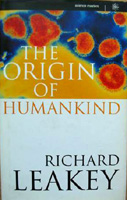 The short answer is almost certainly Africa, anything up to about 100,000 years ago. Leakey, however, is interested in more than just our biological evolution and anatomical relationships with earlier hominids - he looks also at what it was that characterised our ancient ancestors as 'people like us'. He defines this as '... humans with a flair for technology and innovation, a capacity for artistic expression, an introspective consciousness and a sense of morality.'
The short answer is almost certainly Africa, anything up to about 100,000 years ago. Leakey, however, is interested in more than just our biological evolution and anatomical relationships with earlier hominids - he looks also at what it was that characterised our ancient ancestors as 'people like us'. He defines this as '... humans with a flair for technology and innovation, a capacity for artistic expression, an introspective consciousness and a sense of morality.'
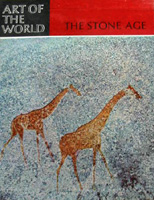 He considers the purpose of art, language and socio-economic cooperation in our evolutionary progress. All of these questions he approaches with the scientist's insistence that whatever speculative ideas are put forward, they must be tested against that which can be supported by evidence. Anything other than that is no more than conjecture
He considers the purpose of art, language and socio-economic cooperation in our evolutionary progress. All of these questions he approaches with the scientist's insistence that whatever speculative ideas are put forward, they must be tested against that which can be supported by evidence. Anything other than that is no more than conjecture
Given that fossilisation is, in effect, the failure of Earth's otherwise ultra-efficient recycling process, relatively few remains are available for scientific analysis. Soft tissue and artefacts made of easily de-compostable materials rarely survive. Even bone ultimately dissolves.
Stone tools and implements survive better, as do the few remains of our forebears whose bodies, by chance, lay in conditions both favourable to fossilisation and accessible to fossil gatherers. More has been lost than remains, so paleontologists are in effect constantly looking for the proverbial 'needle in a haystack'. Richard Leakey has the ability not only to find the needle, but also to suggest what it was used for and he paints a convincing portrait of the kind of person who might have used it and in what kind of society. He is very careful, when dealing with the complexities of scientific evidence, never to oversimplify yet nonetheless to make it accessible to the non-scientific general reader. He is also meticulous in presenting several sides to ongoing debates within the scientific community, striking an impressive balance, whilst never shying away from the conclusions that he is most drawn to. Nothing is ever fully concluded but rather subject to further exploration, discovery and validation.
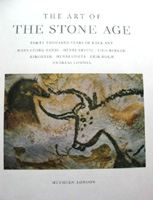 Much significant information, of course, leaves virtually no trace in the fossil record. Language, ritual, dance, story telling etc. leave no hard archeological evidence. We can nonetheless discern ritual activity from burial practices, the existence of art and music from cave paintings and assorted surviving artefacts and it is highly unlikely that language would have suddenly sprung fully formed without also a gradual process of evolution. What they talked about we can only guess. It wouldn't have been last night's telly but might have included comments on so and so's storytelling around the fire and most probably some talk at least about the weather. They too probably began an, at first, magical speculation over the question 'Where do we come from?' Much of this has been transmitted orally from generation to generation over the millennia including what anthropologists call 'origin myths' Gradually these would have become more complex and elaborate. Indeed, it could be argued that Leakey is himself, albeit with a scientific rather than superstitious approach, merely carrying on that ancient questioning process.
Much significant information, of course, leaves virtually no trace in the fossil record. Language, ritual, dance, story telling etc. leave no hard archeological evidence. We can nonetheless discern ritual activity from burial practices, the existence of art and music from cave paintings and assorted surviving artefacts and it is highly unlikely that language would have suddenly sprung fully formed without also a gradual process of evolution. What they talked about we can only guess. It wouldn't have been last night's telly but might have included comments on so and so's storytelling around the fire and most probably some talk at least about the weather. They too probably began an, at first, magical speculation over the question 'Where do we come from?' Much of this has been transmitted orally from generation to generation over the millennia including what anthropologists call 'origin myths' Gradually these would have become more complex and elaborate. Indeed, it could be argued that Leakey is himself, albeit with a scientific rather than superstitious approach, merely carrying on that ancient questioning process.
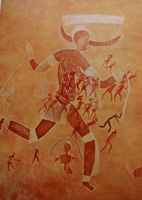 Language itself clearly does not fossilise. It may contain residual traces of its ancestry as English maintains traces of its mongrel heritage. It's a 'bitzer' language - bits o' this and bits o' that. Beyond possibly it's Latin 'DNA' it is difficult to go. Without modern recording equipment language and indeed all ancient sounds, including music, would have been as transitory as a breath of air. Where it was stored, in the soft memory tissue of the brains of the talkers, musicians and their respective audiences would have long since perished. What does remain however are, for example, small bone flutes from the Upper Paleolithic Age (about 20,000 years ago) found all over South West Europe. Clay figurines were also produced in abundance during this era. What exact purposes these objects served we can only speculate. What possible music was produced around communal fires we can barely imagine. Yet it is not speculative to recognise in the existence of tools, instruments and figurines, imaginative minds which conceived them before cutting, shaping, pressing and moulding them into existence. In so doing transforming raw materials into objects - objects of function, utility and beauty.
Language itself clearly does not fossilise. It may contain residual traces of its ancestry as English maintains traces of its mongrel heritage. It's a 'bitzer' language - bits o' this and bits o' that. Beyond possibly it's Latin 'DNA' it is difficult to go. Without modern recording equipment language and indeed all ancient sounds, including music, would have been as transitory as a breath of air. Where it was stored, in the soft memory tissue of the brains of the talkers, musicians and their respective audiences would have long since perished. What does remain however are, for example, small bone flutes from the Upper Paleolithic Age (about 20,000 years ago) found all over South West Europe. Clay figurines were also produced in abundance during this era. What exact purposes these objects served we can only speculate. What possible music was produced around communal fires we can barely imagine. Yet it is not speculative to recognise in the existence of tools, instruments and figurines, imaginative minds which conceived them before cutting, shaping, pressing and moulding them into existence. In so doing transforming raw materials into objects - objects of function, utility and beauty.
This is true of cave paintings also. We are still unsure as to the full purpose and meaning of cave paintings. Some people dismiss them as no more than the idle doodlings of primitive minds. To others, they represent some long lost location for possibly elaborate seasonal, social rituals which formed and reinforced alliances within and between local and possibly distant groups. When Leakey himself looked at the cave art of so called 'primitive' peoples especially in France at sites like Lascaux, he invariably felt the potency of the images and a connection with the people who had produced them, even though their meaning remained elusive. He argues that it is extremely difficult for a mind framed in the modern world to reconcile its connection with our ancient ancestors whose lives had been shaped through eons of existence as hunter-gatherers.
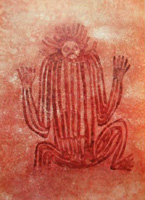 For Leakey, it is the emergence of art about 35,000 years ago, that signifies the point at which we can first identify ancestors who were 'like us' at least in terms of their self-consciousness. No paintings, engravings, carvings or artefacts have been found before this era. He thus concludes that this was the seminal point at which we evolved into recognisable 'humans'.
For Leakey, it is the emergence of art about 35,000 years ago, that signifies the point at which we can first identify ancestors who were 'like us' at least in terms of their self-consciousness. No paintings, engravings, carvings or artefacts have been found before this era. He thus concludes that this was the seminal point at which we evolved into recognisable 'humans'.
The whole process of the evolution of human consciousness has left many subtle and ambiguous markers along the way, which allow for a diversity of interpretations. Here Leakey asks questions about not only the origins of human consciousness but also its purpose. What function does consciousness serve? In this, he recognises he is wandering into a field of enquiry usually the reserve of philosophers. He looks at humankind's growing self-awareness over the mind-numbing millions of years it has taken us to separate from the common biological ancestors we share with other primates. He acknowledges that some of the questions that anthropologists ask - particularly in relation to human consciousness - may be unanswerable. The evolutionary hard evidence may not exist or is so elusive as to remain eternally mysterious. No matter how many answers we get, the questions keep on coming. Such is life.
Reputedly, Henry Ford said that 'History is bunk.' What he actually said to the Chicago Tribune was 'History is more or less bunk. It's tradition. We don't want tradition. We want to live in the present, and the only tradition that is worth a tinker's damn is the history that we make today.' I do not share Ford's view of history. By shining some light into a dim and distant aspect of our species history, Richard Leakey has both enriched and enlightened my life. I feel that I have a deeper understanding of what it truly means to be human.
Contributed by Pete Solan
(Published on 12th Dec 2014 )

